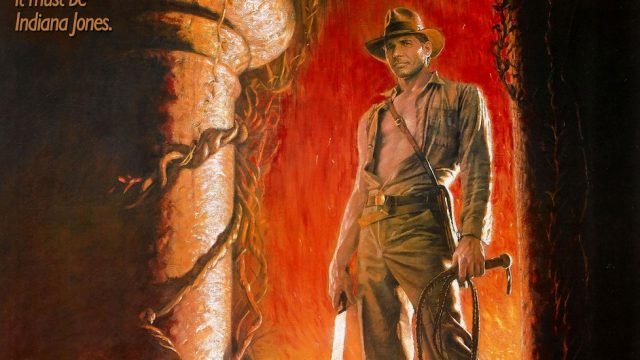Growing up, I watched the Indiana Jones movies incessantly. Correction: I watched Raiders of the Lost Ark and Indiana Jones and the Last Crusade incessantly, so much so that the VHS boxes for both are burned into my memory, the orange block lettering promising adventure. Our VHS of Indiana Jones and the Temple of Doom, on the other hand, was a blank tape with “Temple of Doom” written on a label on the side in my father’s untidy scrawl. It was years before I knew there was a third Indiana Jones movie, and years more before my mother stopped shooting down my requests to watch it. “Too gross,” was her response. All it took was my first viewing as a teenager to agree with her. Too dark. Too violent. Too gross.
My parents were certainly not alone in finding the film an unpleasant watch. The film was, of course, a massive hit, even if it didn’t outgross its predecessor. But it became known as everyone’s least favorite Indiana Jones movie (at least until Kingdom of the Crystal Skull came along), and its unrelenting darkness and violence caused such controversy that it (along with Gremlins) led to the creation of the PG-13 rating. When people think about Raiders or The Last Crusade they think of the famous opening involving Indy outrunning a giant boulder and the interplay between Harrison Ford and Sean Connery (as Dr. Jones Sr.), respectively. When they think of this movie, they think of villain Mola Ram (Amrish Puri, the series’ best villain) pulling out some poor soul’s still-beating heart.
To be fair, director Steven Spielberg and producer George Lucas (who also has a “story by” credit) do themselves no favors with the film’s plotline. Not wanting to repeat themselves and make Nazis the villains again, Spielberg and Lucas decided to make a prequel and set it in India. While the instinct to differentiate the sequel is admirable, it leads to moments that are racist at worst and uncomfortably tone-deaf at best. The series has always dealt with larger-than-life manifestations of good and evil, but the cartoonish representation of the Thuggee cult forces Indy closer to white saviorhood than necessary. A supposedly comic dinner scene that ends with chilled monkey brains being served for dessert is disgusting in all the wrong ways. And by the end of the film when the forces of imperialist Britain show up to put down the Thuggee cult, it becomes clear that Lucas and Spielberg had it right the first time: Indy is more sympathetic battling an incontrovertible evil.
It’s a shame, really, because the rest of the movie is quite thrilling. Spielberg and Lucas’s instinct to try something different extends to the setpieces, which rank among the best in the series. The film opens with a lush production number, a far cry from the steamy jungle of Raiders, before transitioning into a tense negotiation and Indy’s scrambling attempts to get a vial of antidote. There’s a constant escalation and a beautiful use of space in this scene, establishing props and set decoration (such as the gong in the film’s opening shot) that will come back into play as Indy slowly loses control of his original plan. Spielberg had always wanted to make a James Bond movie, and for 15 minutes, he shows what that might have looked like. This scene, along with a mine cart chase later on, also firmly establishes Indiana Jones as part of the lineage of the silent era comedians. Like Buster Keaton and Harold Lloyd, Spielberg knows how to wring laughs out of deadpan underreactions to imminent danger.
And no one is better at deadpan underreactions than Ford. What gets lost in discussions about this movie is that it may feature some of the best performances in the series. Indiana Jones is incredibly elastic in terms of characterization (it’s telling that in the first 15 minutes of The Last Crusade, he gains everything iconic about his character, and almost none of it relates to his personality), and Lucas and screenwriters Willard Huyck and Gloria Katz have a tremendous amount of fun with that elasticity. Never has the character seemed crazier than he does here, a fact called out during the film’s climax by love interest Willie Scott (Kate Capshaw, who would become Spielberg’s wife).
Capshaw’s acting has been derided for years by the fanbase, and Capshaw herself has dismissed the character as a “dumb blonde,” but her performance may be the part of this film that has aged the best. Capshaw, Ford, and the screenwriters get some real mileage out of the screwball comedy of her romance with Indy, best exemplified when Willie is screaming at him for his supposed disinterest in her, not knowing that he’s fighting off an assassin in the next room. There’s also an ingratiating meta element to Willie. After all, if any of us were on an Indiana Jones adventure, would we really handle it better than she does?
In the years since its release, Temple of Doom has enjoyed a troubled relationship with much of its creative team. Spielberg claimed that meeting Capshaw was the only good thing to come out of it. Lucas blamed the film’s darkness on his divorce from Marcia Lucas (while still defending the film overall). And while the film had its defenders, among them Roger Ebert and Pauline Kael, Spielberg and Lucas came back five years later with another Indiana Jones film that once again paired him with Sallah and Brody and had him fight Nazis and search for a Judeo-Christian artifact. It was a safe move, and a predictable one. As the backlash against Kingdom of the Crystal Skull proved, just because the concept of an Indiana Jones movie is nebulous, that doesn’t mean the public doesn’t know what they want out of his adventures.

